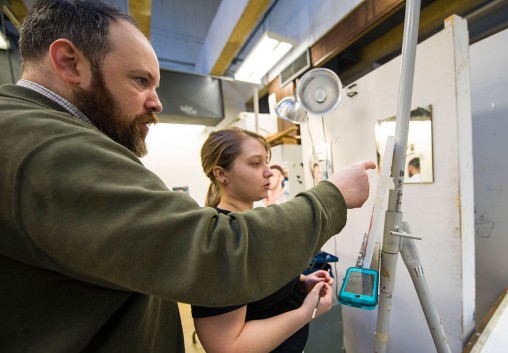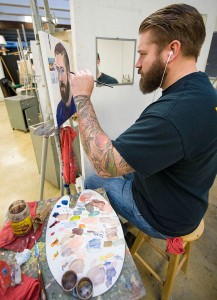
Wright State’s Department of Art and Art History is offering a new studio arts minor to help students develop artistic skills and expand their understanding of aesthetics and visual literacy.
Wright State students can explore their creative sides through a new studio arts minor offered by the Department of Art and Art History.
The new minor is designed for students not majoring in studio art. It will help students develop their artistic and conceptual skills and expand their understanding of aesthetics and visual literacy.
Glen Cebulash, professor and chair of the Department of Art and Art History, said the minor complements the liberal arts emphasis on critical thinking, or what he called “critical looking.”
“We try to instill that in our students, that they’re simultaneously exploring their own creative and expressive interests while learning a language that will allow them a greater degree of articulation and clarity in all that they choose to express and create,” he said.

Students earning a studio art minor can either survey several studio practices or concentrate in a specific medium, like drawing, painting, photography, printmaking or sculpture.
The lessons and skills students will learn in the program can help them throughout their college experience and in their careers, Cebulash said. “This could be particularly appealing for students in STEM disciplines or in disciplines that are otherwise unrelated to visual art,” he said.
After taking a drawing course last summer, Gabe Loranger, a sophomore mechanical engineering major, plans to enroll in the program.
Loranger took art classes in grade school, architecture in high school and has been drawing recreationally since he was 15. But he had never taken a dedicated art course before last summer.
“After taking the class I’ve gotten more serious about developing my skills,” he said.
Loranger sees similarities between engineering and art. As an engineering student, he said, “I’ve always been interested in making things, trying to make something new.” For him, “art is basically the same thing,” although he says he approaches it recreationally.
To earn the studio art minor, students must take 18 credit hours, including two required courses, Themes in Visual Culture and Beginning Drawing, and four studio art courses.
Themes in Visual Culture provides an overview of history of art and approach to aesthetics and art appreciation, while the drawing course is “foundational to everything that we do,” Cebulash said.
“We think everything flows from the kinds of skills and foundations that are inherent in a Beginning Drawing class,” he said.
Cebulash said the minor is designed to be flexible, allowing students to either survey several studio practices or concentrate in a specific medium, like drawing, painting, photography, printmaking or sculpture.
The department also offers an art history minor, which gives students a sense of the evolution of the history of art as well as in-depth knowledge of several periods in the history of art.
Learn more
Students must have an advisory meeting with Cebulash before enrolling in the Studio Arts minor. To learn more or set up an appointment, contact the Department of Art and Art History at (937) 775-2896 or nancy.patton@wright.edu.
More information is also available on the department’s website.

 Thousands celebrate the end of Spring Semester with food, fun and friendship
Thousands celebrate the end of Spring Semester with food, fun and friendship  Nearly 1,500 students to graduate at Wright State’s spring commencement ceremonies
Nearly 1,500 students to graduate at Wright State’s spring commencement ceremonies  Difficult conversations
Difficult conversations  Celebrated Wright State alum serving his community as surgeon
Celebrated Wright State alum serving his community as surgeon  Wright State University Foundation awards Students First Fund grants
Wright State University Foundation awards Students First Fund grants 